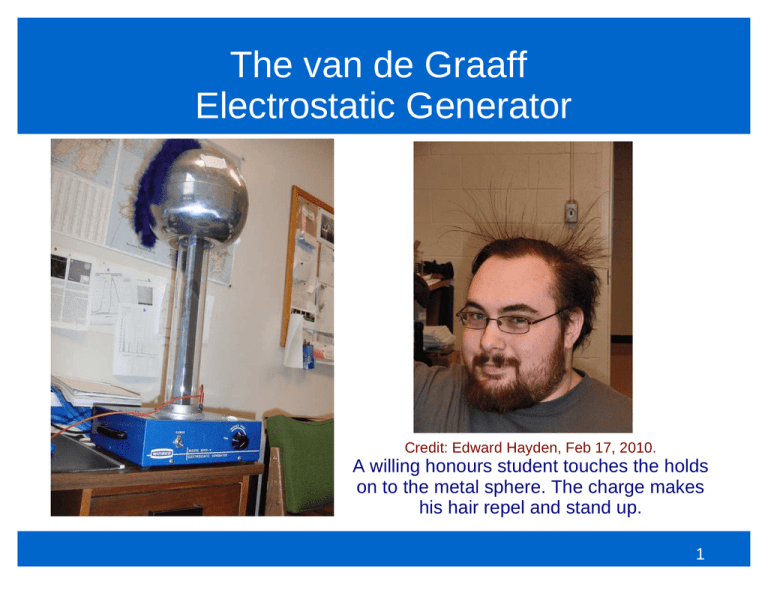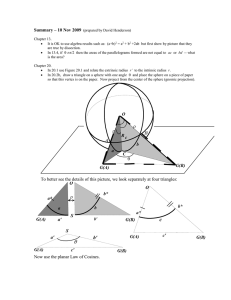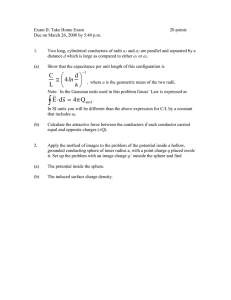The van de Graaff Electrostatic Generator
advertisement

The van de Graaff Electrostatic Generator Credit: Edward Hayden, Feb 17, 2010. A willing honours student touches the holds on to the metal sphere. The charge makes his hair repel and stand up. 1 Conductors: Electric Potential and Charge A metal sphere (radius r1) has an electrical potential that is equal everywhere on its surface How to relate electric field, electric potential and electric charge? radius R Gaussian surface 1. Closed surface : begin with Gauss' Law Imagine drawing a Gaussian surface just outside the sphere 2. From Gauss' Law the flux is: Metal sphere 3. The electric field is: E = E= 1 Q 4 0 R 2 . d s= 1 Q 4. The electric potential is: V = E 4 0 R R Q =E 4 R 2 0 V= 1 Q 4 0 R 2 Conductors: Electric Potential and Charge A big metal sphere and a small metal sphere in electrical contact (e.g. with a wire joining them) will be at the same electrical potential V. radius r1 radius r2 For the big sphere: For the small sphere: 1 Q1 V= 4 0 r 1 1 Q2 V= 4 0 r 2 The big sphere has more charge than the small one. Q1 Q2 = r1 r2 3 Conductors: Electric Potential and Electric Field A big metal sphere and a small metal sphere in electrical contact (e.g. with a wire joining them) will be at the same electrical potential V. radius r1 radius r2 For the big sphere: 1 Q1 V= 4 0 r 1 1 Q1 V = E 1= 2 4 0 r 1 r 1 The field on the big sphere is smaller ! The smaller the radius of curvature the higher the field. Hence, lightning rods are made sharp. For the small sphere: 1 Q2 V= 4 0 r 2 V E 2= r2 E 1 r 1 =E 2 r 2 4 Conductors: Electric Potential and Electric Field Why the spark ? Air is normally a very good electric insulator. But when the electric field is high, this induces breakdown (called dielectric breakdown) of the air. The fresh air smell during a thunderstorm comes from ozone after dielectric breakdown. Earth ground Negative Electric potential The left sphere is the lightning rod : the smaller it is, the easier it is to generate sparks. 5 Electric Potential due to Continuous Charge Distributions Lets return to non-conducting objects. We have considered electric potential due to a point charge and in a uniform electric field. How about a distribution of charges ? For a continuous distribution of charges, consider an infinitesimal (very small) charge dq dq Volume V dV = r dq 1 dq =k e 4 0 r r P V =k e V dq r 6 Electric Potential due to Continuous Charge Distributions: A uniformly charge ring. Example 20.5 in book. Do in class 7 Electric Potential due to Continuous Charge Distributions: A uniformly charge sphere. V outside Radius R D C r V =k e Q r B r/ R V inside V =k e Q 3r / R2 2R r/ R V sphere Note: this different from a conductor, where the charge inside is zero! [Example 20.6 in book. Do in class] r/ R 8 Capacitance Connect two conducting surfaces to the two terminals of a battery. There will be charge buildup of equal magnitude and opposite sign on the two surfaces. Now disconnect the battery. The terminals stay charged. This capacity to store charge is called capacitance. -Q - V + + + + + +Q + + + Capacitance is defined as: Q C= V Reading: All of Chapter 20. 9 Capacitance: The Parallel Plate Capacitor We found the electric field between parallel charged plates was constant : E= 0 or E= Q 0 A Then the potential difference is Qd Q d dx= V =V B V A =A E . d s = 0 A 0 0 A B -Q - A B x=0 x=d d V + + + + + +Q + + + The capacitance is: C= A Q = 0 V d Reading: All of Chapter 20. 10




